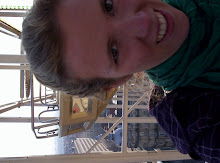
Paris: city of light. Paris: city of love. Paris: city of art. Paris: city of bohemians. Paris: city of fashion. Paris: city of millions. Paris: city that never sleeps. Paris: city of history. Paris: city of Parisiens. Paris: city of old. Paris city of new. Paris: city of parasites. Paris: city of next season. Paris: city of swarming. Paris: city of people.
Coming from a background of limited city exposure it is truly remarkable when you come to a certain realization. A certain realization that a city is not just it’s buildings, it’s roads, it’s parks, it’s population, it’s neighborhoods. When you strip away the urban sprawl, the traffic jams, the congestion, the intimidation-factors-for-a-small-town-girl-in-a-big-world, what is a city? Fundamentally, a city is its people. A city is its culture, its history, its evolution. And each city, as I am discovering, has its own unique circumstances that surround its development to create a unique and endearing persona.
I think the reason my fate is so indelibly intertwined with Psychology is I am deemed to wonder why a person is the way they are. What specific circumstances surround that person to make them the way they are? What context, what history, what potential shapes that persons psyche? It’s fascinating. And I suppose it’s the same for a city, magnified. The way the people contributed, contribute and will contribute to their lives in the metropolis mould the city’s psyche.
In Paris I was struck by the city’s circularity. Geographically, Paris is built in a circular fashion. Louise and I spent twenty minutes looking for a circular point in front of Notre Dame Cathedral. The circular point in the cobblestone square represents kilometre zero. All of Paris’ landmarks are measured against this physical dot. We expected it to be obvious, a beacon, an over-exaggerated, over-photographed tourist location as so many of Paris’ other important attractions are. After a thorough search we finally found it; a subtle disc in the ground maybe15 centimetres in diametre. In the crowded square tourists were stepping on it, not noticing the important landmark under their feet, distracted by the gaudy, gothic-inspired church façade looming above. But there it was. Imagine, everything that is Paris falls upon this point. It is the centre.
Historically Paris was founded because of its optimal defendablity. The river Seine splits around Isle de la Cite creating what is essentially a natural and convenient moat. I suppose over centuries the city grew out from this defensible island. Musee d’Orsay, the Louvre, James Joyce, l’Arc de Triomphe, the Eiffel Tower, Picasso, Dali, the Renaissence, Sartre, le Palais Royal, le Moulin Rouge, Monet, Manet, Cite International, UNESCO, Paris Fashion week; all grew out of this centre. Lately perhaps Paris has become defendable against itself.
The Paris metro is a supremely odd place to be. True to the golden rule of centrality, of circularity, every line careens away from the centre; snaking out from the middle as if it was the city’s collective neuron firing to the beat of the work week. Like a good idea, it fires strong and long, over and over. I have a vivid memory of a poem I read in the 5th grade; the lesson was onomatopoia. The poem portrayed the Chicago subway as a monster; screaming and thundering around corners; careening to an irritable halt and spitting out the swarming passengers like a bitter taste. In the Paris metro this poem was brought back to me. A neuron pathway that had not been lit for 10 years was suddenly aflash. The Paris metro is a monster. It is Medusa’s subterrain hair. Wild and savage beasts circulating by the metronome of the man; mechanical serpants trained to abide by the city’s schedule. They howl their pain in the depths of under-city tunnels; screeching plaints of metal on metal.
If the people of Paris are masters of this monster; en tous cas, it was their good idea, each Parisian is like a parasite feeding off the macrosystem of the city’s infrastructure. Simultaneously controlling the beast all the while lost within its giant barbarity. They are impotent as individuals against this Frankenstein but immeasurably potent as a collective. Converging on the centre, the randomness of their comings and goings becomes remarkably methodic.
So what is this? This massive tangle of history, of centrality, of monstrosity, of human evolution, of parasites disguised in Prada. This is couture and this is culture. This is the centre.

No comments:
Post a Comment